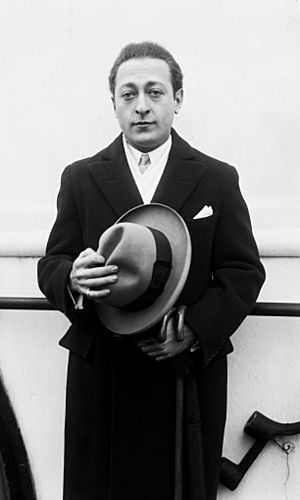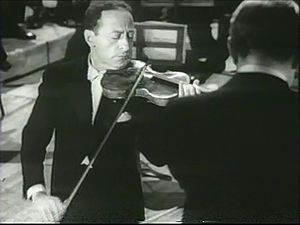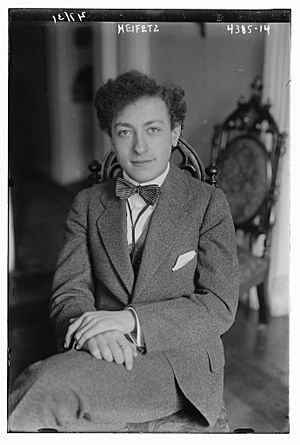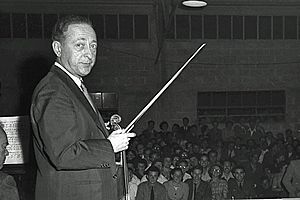Jascha Heifetz facts for kids
Quick facts for kids
Jascha Heifetz
|
|
|---|---|

Heifetz in c. 1920
|
|
| Background information | |
| Born | February 2, 1901 Vilnius, Russian Empire (now Lithuania) |
| Died | December 10, 1987 (aged 86) Los Angeles, California, U.S. |
| Genres | Classical |
| Instruments | Violin |
| Labels |
|
Jascha Heifetz (/ˈhaɪfɪts/; February 2 [O.S. January 20] 1901 – December 10, 1987) was an amazing violin player. He was born in Vilnius, which is now part of Lithuania. When he was a teenager, he moved to the United States. His first performance at Carnegie Hall in New York was a huge success!
Heifetz was a musical genius from a very young age. Another famous violinist, Fritz Kreisler, heard Heifetz play and joked, "We might as well take our fiddles and break them across our knees." This meant Heifetz was so good, other violinists felt they couldn't compare. He had a long and successful career playing the violin. Later in life, after an injury to his bowing arm, he focused more on teaching.
Heifetz also cared about important social issues. He helped make 9-1-1 a national emergency phone number. He also worked to make the air cleaner. He and his students at the University of Southern California even wore gas masks to protest smog. In 1967, he turned his car into an electric vehicle to show how much he cared about the environment.
Contents
Early Life and Amazing Talent
Jascha Heifetz was born into a Jewish family in Vilnius. At that time, Vilnius was part of the Russian Empire.
His father, Reuven Heifetz, was a violin teacher. He also led the Vilnius Theatre Orchestra for a short time. When Jascha was a baby, his father noticed how much he loved the sound of the violin. This made his father believe Jascha had a special gift. Before Jascha was two years old, his father bought him a tiny violin. He taught him how to hold the bow and play simple notes.
At four years old, Jascha started formal lessons. He was a true child prodigy, meaning he was incredibly talented at a very young age. He played his first public concert at seven years old. He performed a difficult piece, the Violin Concerto in E minor by Felix Mendelssohn. In 1910, he went to the Saint Petersburg Conservatory to study with famous teachers.
He played concerts in Germany and Scandinavia. In 1912, he met Fritz Kreisler in Berlin. After the 12-year-old Heifetz played the Mendelssohn violin concerto, Kreisler made his famous joke. He said, "We may as well break our fiddles across our knees!"
Heifetz traveled all over Europe while he was still a teenager. In 1911, he played an outdoor concert in Russia for 25,000 people. The crowd was so excited that police had to protect him after the show! In 1914, he played with the famous Berlin Philharmonic orchestra. The conductor, Arthur Nikisch, said he had never heard a violinist so good.
A Star in America
Heifetz and his family left Russia in 1917. They traveled across Russia by train and then by ship to the United States. They arrived in San Francisco. On October 27, 1917, Heifetz played his first concert in the U.S. at Carnegie Hall in New York. He instantly became a huge star!
Another famous violinist, Mischa Elman, was in the audience. He joked, "Do you think it's hot in here?" The pianist Leopold Godowsky, sitting next to him, replied, "Not for pianists." This meant Heifetz's playing was so amazing, it made other musicians feel a bit "cold" or outshone.
In 1917, Heifetz became an honorary member of a music fraternity called Phi Mu Alpha Sinfonia. At 16, he was likely the youngest person ever to join. He stayed in the U.S. and became an American citizen in 1925. There's a funny story about him and one of the Marx Brothers. When Heifetz said he had been a musician since age seven, the Marx Brother supposedly replied, "Before that, I suppose, you were just a bum."
Heifetz worked with several pianists throughout his career. Brooks Smith was his accompanist for many years. Emanuel Bay, another Russian immigrant, was also a close friend and played with him for over 20 years. Heifetz was so skilled that he would even show his accompanists how he wanted the piano parts to sound.
After the 1955–56 concert seasons, Heifetz decided to play fewer concerts. He said he had been playing for a very long time. In 1958, he had an accident in his kitchen and broke his hip. He recovered, but by 1967, he had greatly reduced his performances.
Heifetz's Unique Style
Many people called Heifetz the greatest violin player since Niccolò Paganini. Paganini was another legendary violinist from a long time ago. Music critic Harold Schonberg said Heifetz "set all standards for 20th-century violin playing." Violinist Itzhak Perlman said Heifetz's goals "still remain, and for violinists today it's rather depressing that they may never really be attained again."
Heifetz's playing style was very important in shaping how modern violinists play. He used a fast vibrato (a trembling sound). He also used portamento (sliding between notes) in an emotional way. His fast playing and amazing bow control created a very special sound. People who knew his music could recognize it instantly. Itzhak Perlman described Heifetz's tone as like "a tornado" because it was so intense.
Heifetz was very careful about his violin strings. He used special gut strings for some notes. He believed that playing on gut strings helped create his unique sound.
Early Recordings and Collaborations
Heifetz made his first recordings in Russia in 1910–11. He was still a student then. These early recordings were not widely known until after he passed away.
After his famous Carnegie Hall debut in 1917, Heifetz started recording for the Victor Talking Machine Company. He stayed with them for most of his career. In the 1930s, he recorded more for EMI in the UK. This was because RCA Victor cut back on expensive classical recordings during the Great Depression.
Heifetz also enjoyed playing chamber music. This is music for a small group of instruments. Some critics said his strong playing style sometimes made it hard for him to blend perfectly with others. But he still made famous recordings with other great musicians. These included cellist Emanuel Feuermann and pianist Arthur Rubinstein. They were sometimes called the Million Dollar Trio. Heifetz also recorded with cellist Gregor Piatigorsky.
Heifetz recorded the Beethoven Violin Concerto in 1940. He played with the NBC Symphony Orchestra. He recorded it again in 1955. He also performed and recorded the Violin Concerto by Erich Wolfgang Korngold. At the time, some classical musicians didn't take Korngold seriously because he also wrote music for movies. But Heifetz still played his music.
World War II and Beyond
During World War II, Heifetz asked composers to write new pieces for him. One was the Violin Concerto by William Walton. He also arranged many pieces, like Hora Staccato. It is said that Heifetz called the composer of this piece, Grigoraș Dinicu, the greatest violinist he had ever heard. Heifetz also played and composed for the piano. He even played jazz for soldiers in Allied camps during the war.
Decca Recordings

From 1944 to 1946, Heifetz recorded with American Decca. This was because of a recording ban by musicians. He recorded mostly short pieces, like his own arrangements of music by George Gershwin. These were often pieces he played as extra songs at the end of his concerts. He even recorded a song with the popular singer Bing Crosby! Soon after, he returned to RCA Victor and continued to record until the early 1970s.
Later Recordings and Challenges
After returning to RCA Victor in 1946, Heifetz made many more recordings. These included solo pieces, chamber music, and concertos with orchestras. He often played with the Boston Symphony Orchestra and the Chicago Symphony Orchestra.
In 2000, RCA released a collection of his best recordings. It included his famous performances of concertos by Brahms, Tchaikovsky, and Sibelius. It also featured his recording of George Gershwin's Three Preludes and Bach's Chaconne.
Tour in Israel
On his third tour to Israel in 1953, Heifetz decided to play a piece by Richard Strauss. At that time, many people in Israel felt that Strauss and other German artists had supported the Nazis. So, their music was unofficially banned. Even though the Holocaust had happened less than ten years before, Heifetz insisted on playing the piece. He said, "The music is above these factors… I will not change my program."
After his concert in Jerusalem, a young man attacked Heifetz outside his hotel. The attacker hit Heifetz's violin case with a crowbar. Heifetz used his right hand to protect his valuable violins. The attacker got away. Heifetz bravely said he would not stop playing the Strauss piece. But he did remove it from his next concert without explanation. His last concert was canceled because his right hand hurt. He left Israel and did not return until 1970.
His Legacy and Teaching
After an operation on his right shoulder in 1972, Heifetz stopped giving concerts and making records. He could still play privately, but his bowing arm was affected.
Heifetz became a dedicated violin teacher. He held special master classes at UCLA and then at the University of Southern California. Other famous musicians like cellist Gregor Piatigorsky also taught there. For a few years, he even taught classes in his home. His teaching studio is now at the Colburn School and inspires students there. Many of his students became successful violinists. See: List of music students by teacher: G to J#Jascha Heifetz.
Death
Jascha Heifetz passed away in Los Angeles, California, on December 10, 1987. He was 86 years old.
Famous Violins
Heifetz owned several very famous and valuable violins. These included:
- The 1714 Dolphin Stradivarius
- The 1731 "Piel" Stradivarius
- The 1736 Carlo Tononi
- The 1742 ex David Guarneri del Gesù
He preferred the 1742 Guarneri del Gesù and kept it until he died. The Dolphin Stradivarius is now owned by a music foundation and is loaned to talented violinists like Ray Chen. The Tononi violin, which he used for his 1917 Carnegie Hall debut, was left to his teaching assistant, Sherry Kloss.
The famous Guarneri violin is now in the San Francisco Legion of Honor Museum. Heifetz wanted it to be played only "on special occasions" by deserving musicians. In 1989, Heifetz received a special Grammy Lifetime Achievement Award after his death.
Family Life
Heifetz's son, Jay, is a professional photographer. He used to work for the Los Angeles Philharmonic and Paramount Pictures. He now lives in Australia. Heifetz's daughter, Josefa Heifetz Byrne, writes dictionaries. She wrote a book called Dictionary of Unusual, Obscure and Preposterous Words.
His great-niece, Michele Zukovsky, is also a famous clarinet player. She used to play with the LA Philharmonic.
Movies and TV Shows
Heifetz appeared in a few movies. In They Shall Have Music (1939), he played himself. He helped save a music school for children. He also appeared in the movie Carnegie Hall (1947). In this film, he played a part of Tchaikovsky's Violin Concerto.
In 1962, he was featured in a TV series of his master classes. In 1971, a special TV show called Heifetz on Television aired. It showed him playing many pieces, including the Scottish Fantasy and Bach's Chaconne. Heifetz even conducted the orchestra in this show.
The most recent film about him, Jascha Heifetz: God's Fiddler, came out in 2011. It tells his life story using family home videos and talks about his accomplishments.
Notable Instruments
- Dolphin 1714 Stradivarius
- Heifetz-Piel 1731 Stradivarius
- Antonio Stradivari 1734
- Carlo Tononi 1736
- Giovanni Battista Guadagnini, Piacenza 1741
- ex-David 1742 Guarneri
Discography
Jascha Heifetz made many recordings throughout his life. All of his recordings are now available on compact disc.
- J.S. Bach Chaconne DVD
- Mendelssohn Octet In E-flat Major
- Mozart Concerto In D Major
- Mozart Symphonie Concertante In E-flat Major
- Stravinsky Suite Italienne
- Toch "Divertimento, Op. 37, No. 2"
- Turina "Trio, Op. 35, No. 1"
- Vieuxtemps Concerto No. 5
- Bach Concerto In A Minor
- Bach "Sonata No. 1, Partita No. 2"
- Bach "Sonata No. 2, Partita No. 3"
- Bach "Sonata, No. 3, Partita No. 1"
- Beethoven Concerto In D Major
- Beethoven "Archduke Trio In B-flat Major, Op. 97, No. 7"
- Beethoven "Sonata In A Minor, No. 4"
- Beethoven Kreutzer Sonata
- Beethoven "Sonata No. 8, Sonata No. 10"
- Beethoven "Trios In G, Op. 9, No. 1"
- Beethoven "Trio In E-flat Major, Op. 3"
- Beethoven Violin Concerto In D
- Beethoven "Trio In D, Op. 9, No. 2"
- Beethoven "Piano Trio, Op. 1, No. 1 "
- Bloch Poème Mystique
- Bloch Sonata
- Brahms Concerto For Violin And Cello
- Brahms Piano Quartet In C Minor
- Brahms "Quintette In G, Op. 111 "
- Brahms Trio No. 1 In B Major
- Brahms "Concerto In D, Op. 77"
- Brahms Violin Concerto
- Brahms 3 Hungarian Dances
- Brahms Concerto, Chausson – Poème, Bruch – Scottish Fantasy
- Bruch Scottish Fantasy
- Bruch "Concerto In G Minor, Op. 26, No. 1"
- Bruch Concerto No. 2
- Castelnuovo -Tedesco ? Concerto No. 2
- Chausson Poème Op. 25
- Dohnányi Serenade In C
- Dvořák "Piano Trio In F Minor, Op. 65"
- Dvořák Piano Quintet In A
- Dvořák Piano Quintet No. 2
- Ferguson Sonata No. 1
- Françaix String Trio
- Franck Sonata In A
- Franck Piano Quintet In F Minor
- Gershwin Porgy And Bess; Music Of France
- Glazounov Violin Concerto
- Glière "Duo For Violin And Cello, Op. 39"
- Handel Halvorsen Passacaglia For Violin And Cello
- J.S. Bach Concerto In D Minor
- Khachaturian "Sonata, Op. 1"
- Korngold "Violin Concerto In D, Op. 35"
- Mendelssohn "Trio In C Minor, No. 2"
- Mendelssohn "Trio No. 1 In D Minor, Op. 49 "
- Mendelssohn Concerto In E Minor
- Mendelssohn Concerto In E Minor
- Mendelssohn "String Octet in E-flat Major, Op. 20"
- Mozart Quintet In C Minor
- Mozart "Divertimento In E=flat Major, K. 563"
- Mozart "Concerto In A, No. 5, K. 219 "
- Mozart "Divertimento In E-flat, Duo In B-flat, No. 2"
- Mozart "Sonata No. 10, K378, No. 15, K454"
- Mozart "Symphonie In E-flat, K. 364"
- Mozart "Violin Concerto, No. 5, K. 219"
- Mozart "Quintet In C, K. 515"
- Paganini 3 Caprices
- Prokofieff "Concerto In G Minor, No. 2"
- Respighi Sonata In D Minor
- Rózsa Concerto
- Saint-Saëns "Sonata In D, No. 1"
- Schubert Fantaisie
- Schubert "Trio No. 1, In B, Op. 49"
- Schubert Quintet In C Major
- Sibelius Violin Concerto
- Spohr Double String Quartet
- Tchaikovsky Violin Concerto In D, Op. 35
- Tchaikovsky Violin Concerto, Sinding – Suite
- Tschaikowsky Violin Concerto
- Tschaikowsky Sérénade Mélancolique
- Vivaldi Concerto For Violin And Cello In B-flat;
- Walton Concerto For Violin
- Arensky Trio In D Minor
- Bach Concerto In E Major
- Beethoven "Sonata In C Minor, No. 7"
- Beethoven "Romances, No. 1 and 2"
- Beethoven "Trios In C Minor, Op. 9, No. 3"
- Beethoven "Spring Sonata In F, Op. 24, No. 5"
- Beethoven "Piano Trio In E-flat, Op. 70, No. 2"
- Brahms Concerto In A Minor
- Bruch Concerto In G Minor
- Castelnuovo-Tedesco "The Lark, Fauré – Sonata, Op. 13"
- Grieg Sonata In G
- Haydn Divertimento, Rózsa – Tema Con Variazioni
- Lalo "Symphonie Espagnole, Op. 21"
- Martin Duo For Violin And Cello
- Schubert Sonatina in G minor
- Schubert "Trio In B-flat, No. 2"
- Strauss Sonata In E-flat
- Tchaikovsky "Trio In A Minor, Op. 50"
- Beethoven "Sonata No. 3, Sonata No. 6"
- Bach Three Sinfonia;
- Bach Concerto For Two Violins
- Beethoven Sonata No. 7
- Beethoven Sonata Nos. 1 &2
- Benjamin Romantic Fantasy
- Benjamin Romantic Fantasy
- Boccherini Sonata In D
- Brahms Sextet In G Major
- Bruch Scottish Fantasy
- Chausson Concerto For Violin
- Conus Concerto In E Minor
- Debussy "Sonata In G Minor, No. 3"
- Dvořák "Piano Trio, Dumky"
- Grieg "Sonata No. 3, Brahms – Sonata No. 1
- Wieniawski, Tchaikovsky, Rameau, J.S.Bach, Padilla, Sarasate"
- Handel Halvorsen – Passacaglia
- Handel Sonata In E Major
- Mozart "Sonata In C, No. 8, K. 296"
- Mozart "Concerto In D, No. 1, K. 218"
- Prokofieff Concerto In G Minor
- Ravel Trio In A Minor
- Ravel Tzigane
- Saint-Saëns "Sonata In D Minor, Op. 75, No. 1"
- Schubert Sonata In G Minor
- Spohr Concerto No. 8
- Strauss Sonata In E-flat
- Toch Vivace molto
- Vieuxtemps "Concerto In A Minor, Op. 37, No. 5"
- Vitali Chaconne
- Wieniawski Concerto No. 2
See also
 In Spanish: Jascha Heifetz para niños
In Spanish: Jascha Heifetz para niños
- Jascha Heifetz Competition




